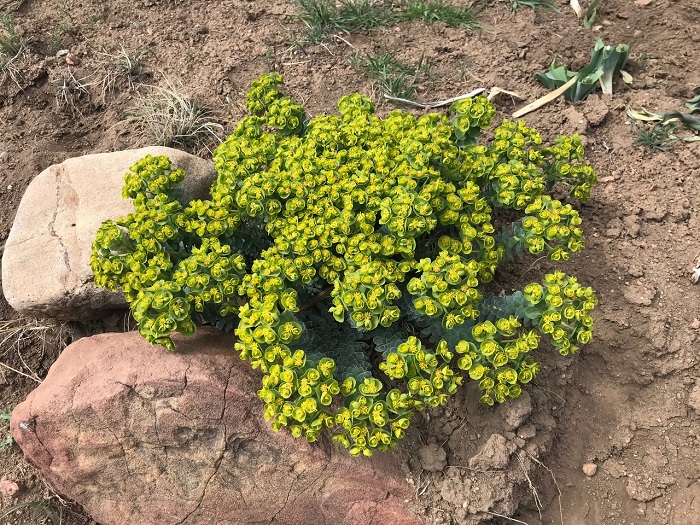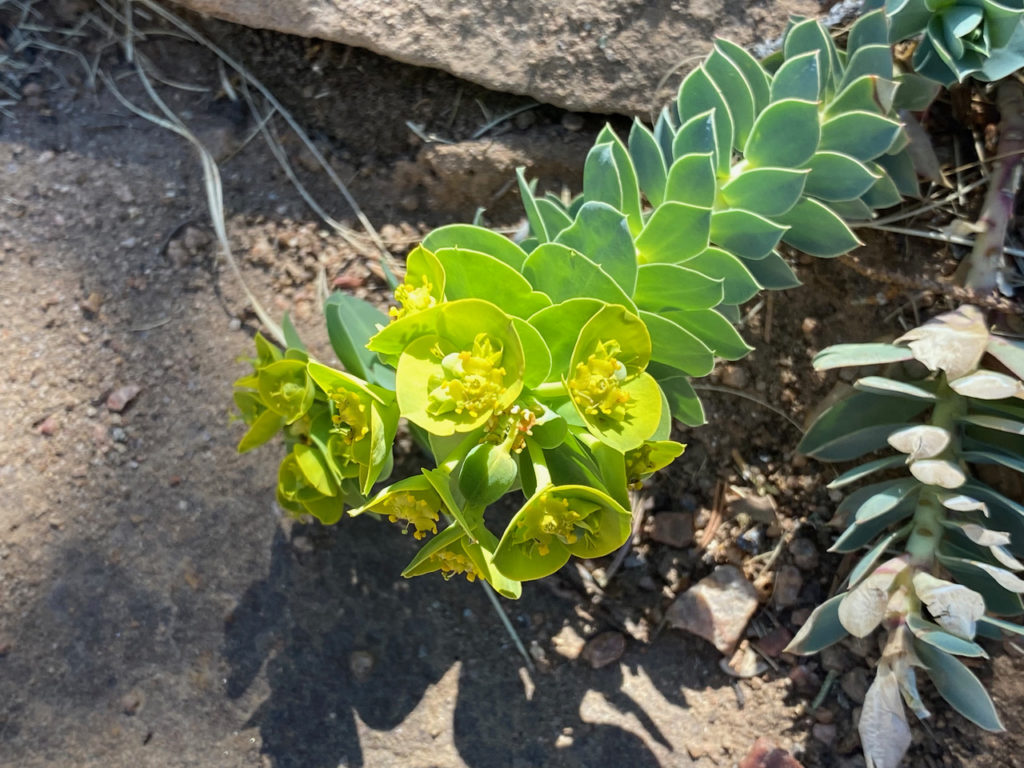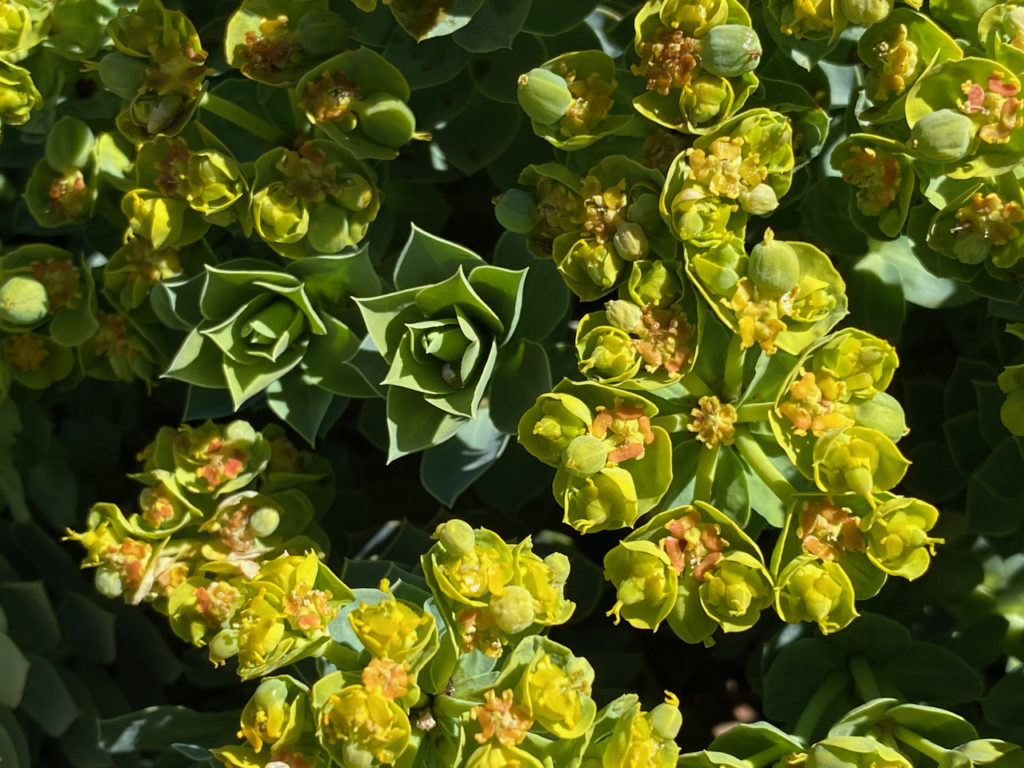Scientific Name: Euphorbia myrsinites
Common name: myrtle spurge
Family: Euphorbiaceae
Article by Susan Bruneni
Myrtle spurge can claim notoriety for two very opposite traits. On one hand it appears on at least seven lists of noxious weeds in the U.S. Northwest and Southwest (including New Mexico) and is illegal to grow in some western states. But, at the opposite end of the spectrum it is listed on the prestigious “Award of Garden Merit” by the Royal Horticultural Society (U.K.), a list of the best garden plants.

Myrtle spurge. Photo by Kathy Haq.
For a time, myrtle spurge was the preferred choice for “water wise” gardens. The plant grows well in shade, requires little in the way of hydration, grows in disturbed environments, and is an attractive ornamental. It is ideal for borders, rock gardens, ground cover, and pots where it can trail over the sides. It is an excellent xeriscape plant. And it is resilient to most garden pests, salt tolerant, and deer- and rabbit- resistant. It prefers full sun and well-drained soil.

Myrtle spurge, photo: Kathy Haq.
Leaves are alternate in tight spirals, grey-blue, thick, waxy, oval to wedge-shaped and pointed at the tip. Flowers are yellow-green, cupped inside a yellow bract, and grow in clusters. Flowers bloom from mid spring to early summer. Each flower produces a bluish-green seed pod that contains three, 0.13 inch long seeds. It grows commonly in the Santa Fe area and is one of the first plants to emerge in spring. It grows to six inches in height with trailing one-foot stems.

Myrtle spurge, photo: Kathy Haq.
It is native to southern Europe and Central Asia and was widely imported into the U.S. for ornamental use. But myrtle spurge very quickly spread from home gardens, outgrowing and shouldering out native plant species especially in Salt Lake City, Utah, where its spread is termed “grim”. It has earned the dubious title of “escaped ornamental”. At present, myrtle spurge has no predators to prune back its advance.
Its root systems grow wide underground, meaning that pulling out plants at the surface may not be effective. The sap is very caustic and toxic. It can cause rashes, blisters, even blindness if it gets in the eyes, and nausea, vomiting and diarrhea if ingested. Children and pets are more sensitive and myrtle spurge should be removed from any area where they may have contact. All parts of the plant are toxic. The active ingredient in spurges are terpen esters. One such terpen ester is resiniferatoxin, which is 10,000 to 100,000 times more irritating than capsaicin, the substance that makes chili peppers taste hot.
Myrtle spurge can be contained, but this takes constant attention before and during seed production. Mature seed heads rupture, throwing seed up to fifteen feet away, and seeds can also be ejected when plants are disturbed, sticking to wildlife hair and enabling transport far from the parent plants. The main mode of reproduction is by seed, but root fragments may also produce new plants.
The best method for controlling spread is diligent deadheading before seeds mature, cutting the stem back completely. Wear protective clothing, eye protection, and gloves. Removing at least four inches of root annually may work but will take years.
If you choose removal, use caution when pulling to not get any sap on your skin, especially on the face or in the eyes. If sap contacts skin make sure to wash that area immediately. Intensive cultivation and the planting of competitive crops are useful methods for the control of myrtle spurge in fields. For heavy infestations on rangeland, grazing sheep or goats can diminish growth.
Small infestations can be controlled through multiple years of digging up at least four inches of the root. Myrtle spurge is best controlled in the spring when the soil is moist and prior to seed production. If you choose to use chemical eradication, make sure to check with the City of Santa Fe. A number of popular products are now banned from use on city property due to links with carcinogens. Dispose of cuttings. Do not compost. It is also important to remove all seeds before dispersal. There are no known biological controls at this time.
Ironically, myrtle spurge gained immense popularity for xeriscaping but it has been shown to require constant maintenance to prevent it from joining its companions who roam the native terrain as a band of invincible “escaped ornamentals”.
References
Wikipedia
gardenia.net
nhmu.utah.edu.
usda.plants.gov
Missouribotanicalgarden.org


